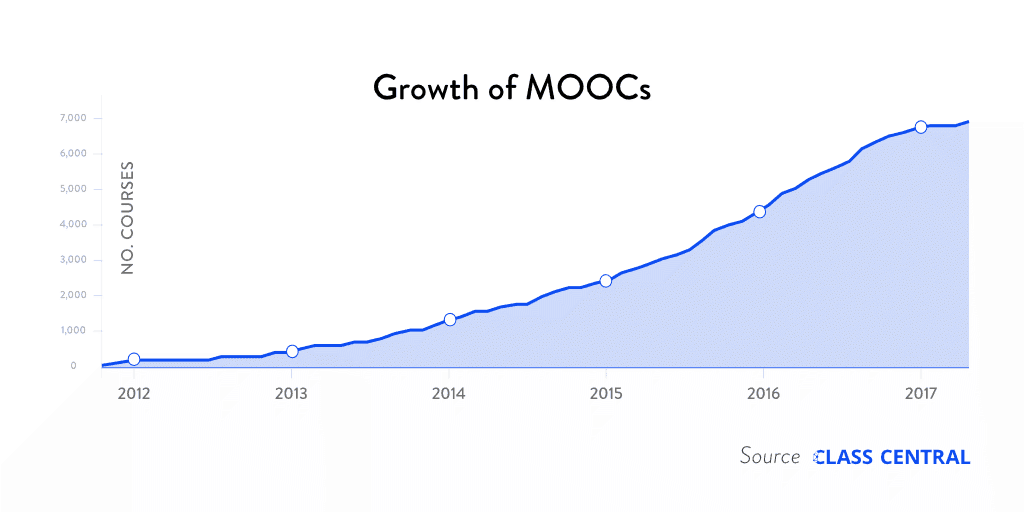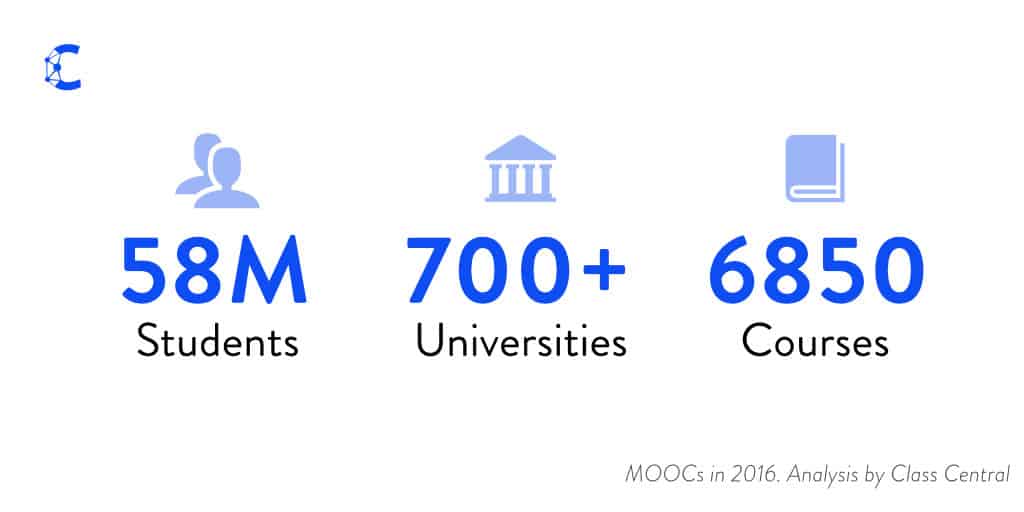By The Numbers: MOOCS in 2016
How has the MOOC space grown this year? Get the facts, figures, and pie charts
This article is just one in our 2016 MOOC Roundup Series. Find the whole series of articles here, and discover everything MOOCs in 2016 — from the most popular classes, to overviews on developments in MOOC platforms, to looking at the MOOC-future.
The “modern” MOOC movement (which started in late 2011—when the first Stanford MOOCs took off) is now a half a decade old.
In it’s fifth year, 23 million people worldwide registered for a MOOC for the first time ever, according to data collected by Class Central. This makes the total number of students who signed up for at least one MOOC estimated to be 58 million.
As MOOC providers become increasingly focused on monetization, the growth rate in terms of users has slowed down. A quarter of the new users added in 2016 have come from regional MOOC providers such as XuetangX (China) and Miríada X (Latin America).
Here is a list of top five MOOC providers by registered users:
- Coursera – 23 million
- edX – 10 million
- XuetangX – 6 million
- FutureLearn – 5.3 million
- Udacity – 4 million
XuetangX burst onto this list making it the only non-english MOOC platform in top five.
In 2016, 2,600+ new courses (vs. 1800 last year) were announced, taking the total number of courses to 6,850 from over 700 universities.

Note that the total of number of courses represents all the courses that have launched, and many of them are no longer available.
Credentials
The number of MOOC-based credentials–sequences of MOOCs that result in a certification in a specific topic area, grew by 150% to over 250 this year. The aim of these credentials is to signify a level of competence for high-demand skills.
- Coursera accounts for the marjority of these with over 160 Specializations.
- EdX expanded their MicroMasters credential program, which was piloted with MIT last October. The MicroMasters credential has been adopted by fourteen universities located in eight different countries.
- This year we saw FutureLearn and Kadenze launch their own MOOC-based credentials.
For MOOC providers that have started down the path of offering credentials, the majority of their new courses have are attached to credentials.
Subjects
Consistent with last year, courses in Business and Technology (Computer Science, Data Science, Programming) form a big chunk of the courses that have been announced so far. The business category grew by 3% this year.
This makes sense as the most common way for MOOC providers monetize via certificates is to tackle applied skills in the fields of business and technology.
Providers
With 1700+ active courses, Coursera is still the largest MOOC provider even after discontinuing hundreds of courses.
EdX is not far behind with 1300 courses, followed by FutureLearn with 480 courses. \
After this there is Latin American MOOC provider Miríada X with 350 courses in Spanish followed by XuetangX with 300+ courses in Chinese.
As we see with these numbers, MOOCs are still growing at rapid pace. The largest providers are moving towards credentials, which provides both monetization and, hopefully, valuable recognition for learners efforts. The focus on creating these credentials explains why the fastest growth in number of courses comes from the smaller and regional providers. It may be that we will see more types of MOOCs and models to fit the needs of learners and providers around the world.
Tags









Muvaffak GOZAYDIN
Wonderful Report .
We need to know also
1.- How many people just registered to any MOOC starting 1.1.2012
2.- How many registgered for only one course, how many for 2 courses , how many for 3 courses, how many for 4 courses , how many for 5 courses, how many more than 5 courses just clicked to registere .
3.- How many people got only one certificate since 1.1.2012
How many 2 certificates,
hoıw many 3 certificates,
how many 4 certificates,
how many 5 certificates
how many more than 5 certificates
4.- At the end of every month we need to know
( only for that month )
a) How many registered first time to any MOOC
b) How many registere his first certificate,
how many 2
…
…
…
how many more than 5 certificates
5.- How many new courses for credits start ed
Lenaarts Adam
@mgozaydin:disqus besides quantative reporting we should also have a qualitative survey of the UX the various MOOC’s are offering. Is there any independent report on that available??
Toke Faurby
Are there any numbers on at what level the MOOCs are (e.g. High school vs College vs University vs Professional)
Nachimani
MOOC has revolutionized the world. At advan-kt (www.advan-kt.com) , we accept 12 modules for Diploma, 24 modules for Bachelor degrees in science and arts. 36 modules are considered for Master degree. So far 5 universities have joined us.